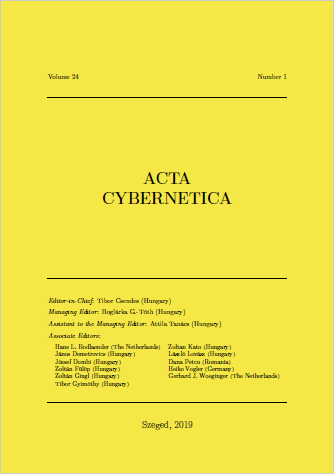Towards a Classification to Facilitate the Design of Domain-Specific Visual Languages
DOI:
https://doi.org/10.14232/actacyb.24.1.2019.2Keywords:
domain-specific visual languages, modeling, classificationAbstract
Domain-specific visual languages (DSVLs) are specialized modeling languages that allow the effective management of the behavior and the structure of software programs and systems in a specific domain. Each DSVL has its specific structural and graphical characteristics depending on the problem domain. In the recent decade, a wide range of tools and methodologies have been introduced to support the design of DSVLs for various domains, therefore it can be a challenging task to choose the most appropriate technique for the design process. Our research aims to present a classification to guide the identification of the most relevant and appropriate methodologies in the given scenario. The classification is capable enough to provide a clear and precise understanding of the main aspects that can facilitate the design of DSVLs.
Downloads
References
Beydeda, Sami, Book, Matthias, Gruhn, Volker, et al. Model-driven software development, volume 15. Springer, 2005.
Blockly website. https://developers.google.com/blockly/. Accessed: 2018-08-22.
Bottoni, P. and Grau, A. A suite of metamodels as a basis for a classification of visual languages. In 2004 IEEE Symposium on Visual Languages - Human Centric Computing, pages 83-90, Sept 2004. DOI: 10.1109/VLHCC.2004.5.
Bottoni, Paolo and Ceriani, Miguel. Sparql playground: A block programming tool to experiment with sparql. In VOILA@ISWC, 2015.
Burnett, Margaret~M. and Baker, Marla J. A classification system for visual programming languages. J. Vis. Lang. Comput., 5:287-300, 1994.
Emf website. http://www.eclipse.org/modeling/emf/. Accessed: 2018-08-25.
Fraser, Neil. Ten things we've learned from blockly. In Blocks and Beyond Workshop (Blocks and Beyond), 2015 IEEE, pages 49--50. IEEE, 2015.
Lego wedo 2.0. https://education.lego.com/en-us/downloads/wedo-2/software. Accessed: 2018-08-21.
Marriott, Kim and Meyer, Bernd. On the classification of visual languages by grammar hierarchies. Journal of Visual Languages and Computing, pages 375--402, 1997.
Mernik, Marjan, Heering, Jan, and Sloane, Anthony M. When and how to develop domain-specific languages. ACM Comput. Surv., 37(4):316--344, December 2005. DOI: 10.1145/1118890.1118892.
Myers, Brad A. Taxonomies of visual programming and program visualization. J. Vis. Lang. Comput., 1(1):97--123, March 1990. DOI: 10.1016/S1045-926X(05)80036-9.
Pasternak, Erik, Fenichel, Rachel, and Marshall, Andrew N. Tips for creating a block language with blockly. In Blocks and Beyond Workshop (B&B), 2017 IEEE, pages 21--24. IEEE, 2017.
Scratch. https://scratch.mit.edu/. Accessed: 2018-08-25.
Sirius website. https://www.eclipse.org/sirius/. Accessed: 2018-08-20.
Sprinkle, Jonathan and Karsai, Gabor. A domain-specific visual language for domain model evolution. Journal of Visual Languages & Computing, 15(3-4):291--307, 2004.
Sysml. https://sysml.org/. Accessed: 2018-08-29.
Uml. http://www.uml.org/. Accessed: 2018-08-29.
Vmts website. https://www.aut.bme.hu/Pages/Research/VMTS/Introduction. Accessed: 2018-08-21.







